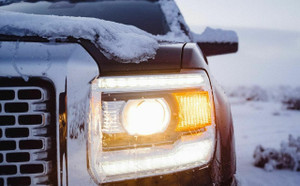How to prepare for driving in the snow
By Kijiji Autos
Whether you've recently moved provinces or are gearing up for your first winter behind the wheel, driving in the snow can often be an unnerving experience. It takes a special approach and lots of patience to get comfortable driving on slippery surfaces. These tips are designed to help you master the art of driving on snow and ice.
Plan ahead as much as possible
You’ll quickly learn that driving in winter can be made much easier by simply setting aside some time to prepare. Write up a mental list of things to check before heading out into the snow:
- How’s your car? Inspect the tires, brakes, battery, engine and windshield.
- What’s the weather forecast? Although driving in the snow isn’t always avoidable, you might want to hang up the keys if a blizzard is coming.
- Do you have a winter survival kit? This is comprised of simple items, such as an ice scraper, safety vest, antifreeze, extra blankets, etc., to ensure you’re covered should something unexpected happen while on the road.
Better safe than sorry
It’s important to give yourself plenty of time when driving in the snow, and it’s always dangerous to rush and speed while behind the wheel. You become especially hazardous to yourself and everyone else on the road when you speed in the snow.
Staying alert is crucial during winter driving. A road may suddenly become more slippery depending on a number of factors. Certain streets are plowed and salted more frequently than others, while even the type of concrete or asphalt can determine how slick a stretch of road might be. Pay attention to your surroundings and drive defensively.
Give other people lots of space
While the normal following distance rule in optimal conditions should be three to four seconds, you should give much more space to other drivers in the snow, closer to 8 to 10 seconds. Don’t expect that you’ll be able to quickly accelerate or maneuver between lanes—it’s important to be considerate of other drivers and on high alert. If you’re driving on the highway, be wary when trying to overtake another vehicle or large truck. Not only will falling snow greatly decrease your visibility, some parts of the road that remain untouched by other vehicles might be particularly slippery.
It’s crucial to remember that braking distances are significantly increased in icy conditions. Assuming the reaction times are identical, a vehicle traveling at 50 km/h on a dry road might need upwards of 35 metres to safely come to a stop. Comparatively, a car traveling at the same speed on an icy road will need at least 85 metres to come to a safe stop. This is also based on the presumption that other cars are equipped with winter tires—the distance will be even greater if they aren’t.
Driving in snow can be a stressful order for even the most experienced of motorists. That’s why it’s important to ensure that you’re up for the task. By preparing in advance and respecting the rules of the road, even the most inexperienced winter driver can master the elements.
If you’re looking for a vehicle for the snowy season, Kijiji Autos has a wide selection of winter-ready cars.
Easily find your next ride on Kijiji Autos
Search nowHow Long Can a Car Sit Unused?
How long can a car be left without starting it? Keep reading to explore everything you need to know about unused cars.Costs of Installing an Electric Car (EV) Charging Station in Canada
Installing a home EV charger can come with additional fees beyond purchase and installation. Here's a list of factors that can affect the price of a home EV charger.Toronto to Calgary Road Trip: Routes & Tips
Planning on driving from Toronto to Calgary? Here are some routes and tips to help you along the way.Flat Tire vs Blowout: What's the Difference & What Should You Do?
The main difference between a flat tire and a blowout is that a blowout often feels like an explosion has occurred underneath your vehicle. Blowouts can cause sudden and drastic changes to the handling of your vehicle and can lead to minor or even serious accidents.7 items you can fit in an SUV: TVs, mattresses and more
Discover seven common items that fit in an SUV below.Tips to help protect your vehicle and budget for car repairs
When shopping for your next vehicle, it's always a good idea to keep hidden costs in mind. Before you buy, let's look at how much it can cost to maintain a car in Canada, how much you could budget for annual maintenance and repairs, and how to help protect your car against damage and depreciationThe top three best paint protection options for your vehicle
Buying a new vehicle is a great experience. Nothing beats hitting the road in a car you bought fresh off the lot. However, as fun as it is to finally get behind the wheel of your new ride, it's important to take your time through the process.What is the value of undercoat protection on your vehicle?
When you buy a new vehicle, protecting it so that it lasts as long as possible is definitely top of mind, whether that's through security upgrades or an extra coat of paint. But how often do you consider the care and safety of your vehicle’s undercarriage?Financial guide: post-pandemic car shopping and gas price hacks
With populations locked down and international borders closed the global supply chain has been disrupted on a massive scale, pushing up inflation around the world and raising the cost of everything that people need to get back to normal. Here are a few tips you can use to grab the vehicle you want without breaking the bank.10 tips to help make the road a better and happier place
We have all, at some point, been responsible for making the roadways stressful in one way or another. Alternatively, we are all equally capable of making the road a happier place. Let’s explore 10 unique ways we can help make the driving experience better again, for everyone's sake.








